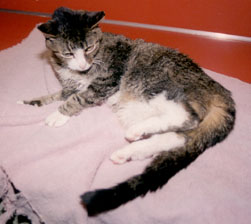
| This cat demonstrates the weight loss that is often associated with hyperthyroidism. |
Introduction:
The thyroid gland is a very small organ found in the neck region of the animal. The thyroid gland is responsible for producing many hormones important for the regulation of metabolism. The most common thyroid problem in cats is an overactive thyroid gland (hyperthyroidism). This problem usually develops in middle aged to older cats. Hypothyroidism or an underactive thyroid gland resulting in low levels of thyroid hormone can occur in the cat, but it is rare.Causative Agents: Hyperthyroidism is most often caused by a tumor of the thyroid tissue. This tumor may actually cause the thyroid gland or glands to enlarge. The tumor is usually benign (has a low risk of spreading), but will overproduce normal thyroid hormones. Occasionally, these tumors are malignant (aggressive) and require additional attention to prevent potential spread of the cancer. The outcome is usually less successful if the tumor is malignant.
Clinical Signs: The typical hyperthyroid cat is very excitable, has an increased heart rate, and an increased appetite. Despite the increase in appetite, these animals often lose weight. Some cats urinate and drink more, have diarrhea and vomiting, and may have difficulty breathing. Some cats may experience severe heart problems, including congestive heart failure and/or life-threatening heart rhythm disturbances. An experienced clinician can often palpate or feel the abnormally enlarged thyroid gland in the neck.

|
|
Diagnosis: The thyroid hormone levels can be measured in a blood sample
taken by a veterinarian. Because not all cases of hyperthyroidism are
straightforward, the results often require some interpretation. The typical
hyperthyroid cat has increased levels of the thyroid hormones T4 and T3. Thyroid
hormone levels tend to fluctuate over days to weeks and a cat with
hyperthyroidism may have cycles of normal to abnormally high hormone levels. For
this reason, a veterinarian may recommend re-testing a cat he or she suspects of
having hyperthyroidism a couple of weeks after obtaining a normal result.
Other types of testing other than blood analysis are also used, but usually
require special equipment and training that may not be readily available at a
local veterinary clinic.
Treatment: Once a diagnosis has been made, the cat can be treated using several different methods depending on the situation. Some cats require surgery to remove all or part of the problem gland. This surgery is difficult and often requires some intense post-surgical hospitalization. These cats may require supplemental calcium and thyroid hormones at first. Thyroxine is the major replacement hormone required in these cats.
Some cats respond well to radiation or radioactive therapy. These procedures are usually only available at highly specialized hospitals. The principle goal with both of these procedures is to reduce and eliminate the diseased thyroid gland tissue.
A final method of treatment involves using drugs that inhibit production of thyroid hormones. The most common drug used is called Tapazole. Tapazole is generally not recommended as a permanent therapy in the ideal situation. However, it is often used in situations where finances are limited (both surgery and radiation therapy are quite expensive) or in some cases where kidney disease occurs with hyperthyroidism.
Some patients require a combination of the above procedures, but all require continued thyroid monitoring to ensure proper and adequate control.